Olivier Frapolli has been managing Stade Lavallois since the summer of 2019 — pre-pandemic, which seems a lifetime ago for some of us now!
In that time, the 51-year-old coach has guided the Mayenne-based club to promotion from Championnat National as league winners (2021/22) before securing Ligue 2 safety last season, ensuring the club would enter the 2023/24 campaign as a second-tier side.
Frapolli deserves plenty of credit for the stability and success he’s brought to Les Tango, who had been absent from Ligue 2 since 2016/17 before he oversaw their promotion.
In this tactical analysis piece, we’ll analyse Frapolli’s performances over the last year and a bit within the context of what he’s had to work with in Laval compared with his competitors before looking at the tactics and tactical identity he’s stamped on his side.
We’ll finish up our analysis by highlighting three key players within his Lavallois team who you need to keep an eye on this season and why those individuals, in particular, could elevate Frapolli’s team in 2023/24 beyond what they achieved last term.
Overachieving this season and last?
One could quite easily argue that Frapolli has overachieved in a major way with Les Tango over the past couple of seasons. Firstly, let’s take a trip back to Lavallois’ first Ligue 2 campaign in six years, one season ago.
Fresh off their Championnat National triumph, the club ended up in the second tier, competing with squads far more potent than theirs. Per Transfermarkt, Les Tango had the lowest squad value of any second-tier side in 2022/23 by a fair distance.
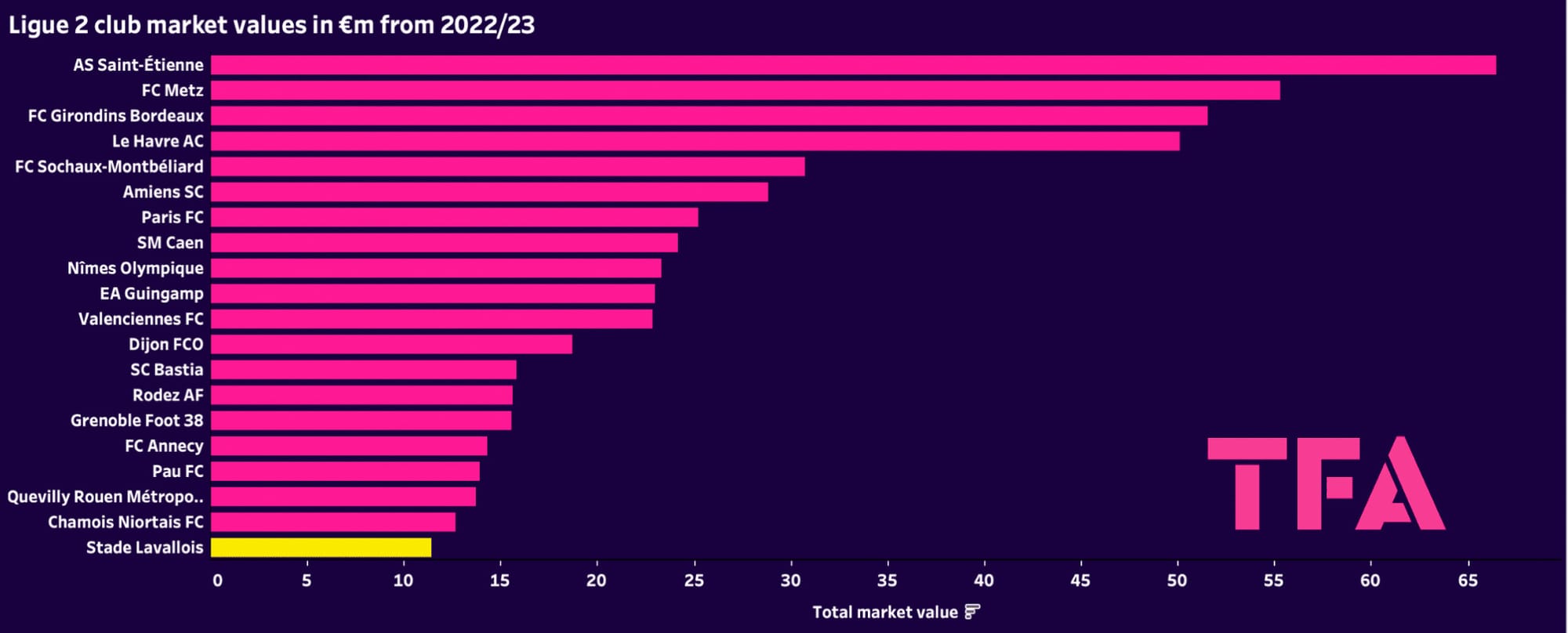
This would suggest lower quality in the squad and more difficulty for all involved when it comes to achieving their aim of avoiding the drop straight back down to the third tier.
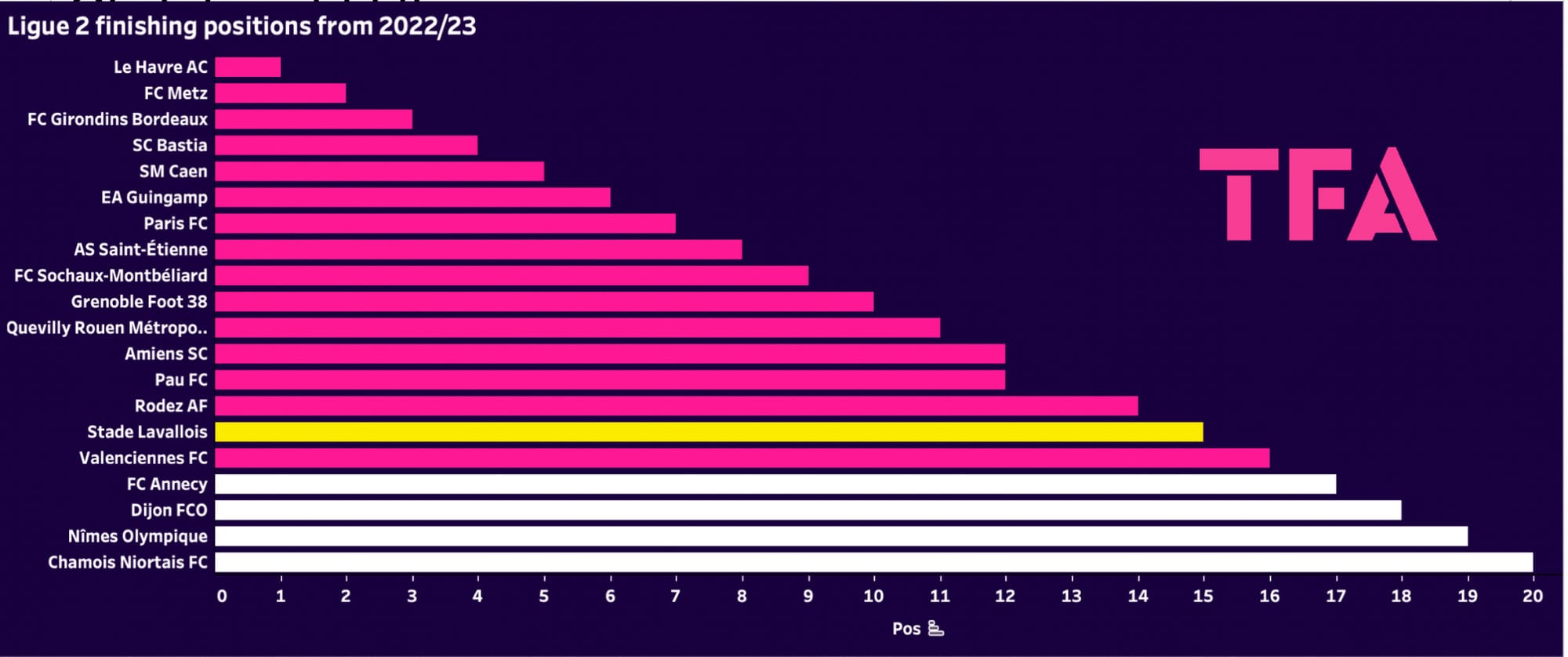
However, avoid the drop they did — despite four teams being relegated from Ligue 2 last season; Lavallois ultimately ended up finishing 15th — two places (though just one point!) clear of the relegation zone.
Due to Sochaux-Montbéliard’s off-the-field issues, which resulted in their relegation, Annecy was handed a lifeline and avoided the drop as the best of the four relegated teams last term. However, Frapolli and his team didn’t know this would happen and managed to achieve their goal without relying on extenuating circumstances.
A team with the lowest market value avoiding the drop, especially in a season with four teams going down, means the head coach deserves credit in my book. Of course, players can overperform, and luck can (or must, realistically) play a factor. However, it can’t all be chalked up to that.
It’s widespread to see the head coach get the blame for underperformance, and often, this is probably justified. In this case, it would appear that the reverse is true. The underlying numbers would back up the fact that Lavallois’ performances earned safety last season — they finished with the sixth-highest xG (50.72) and ninth-lowest xGA (47.02), for instance — performances that hardly act as indicators of relegation despite their low squad value.
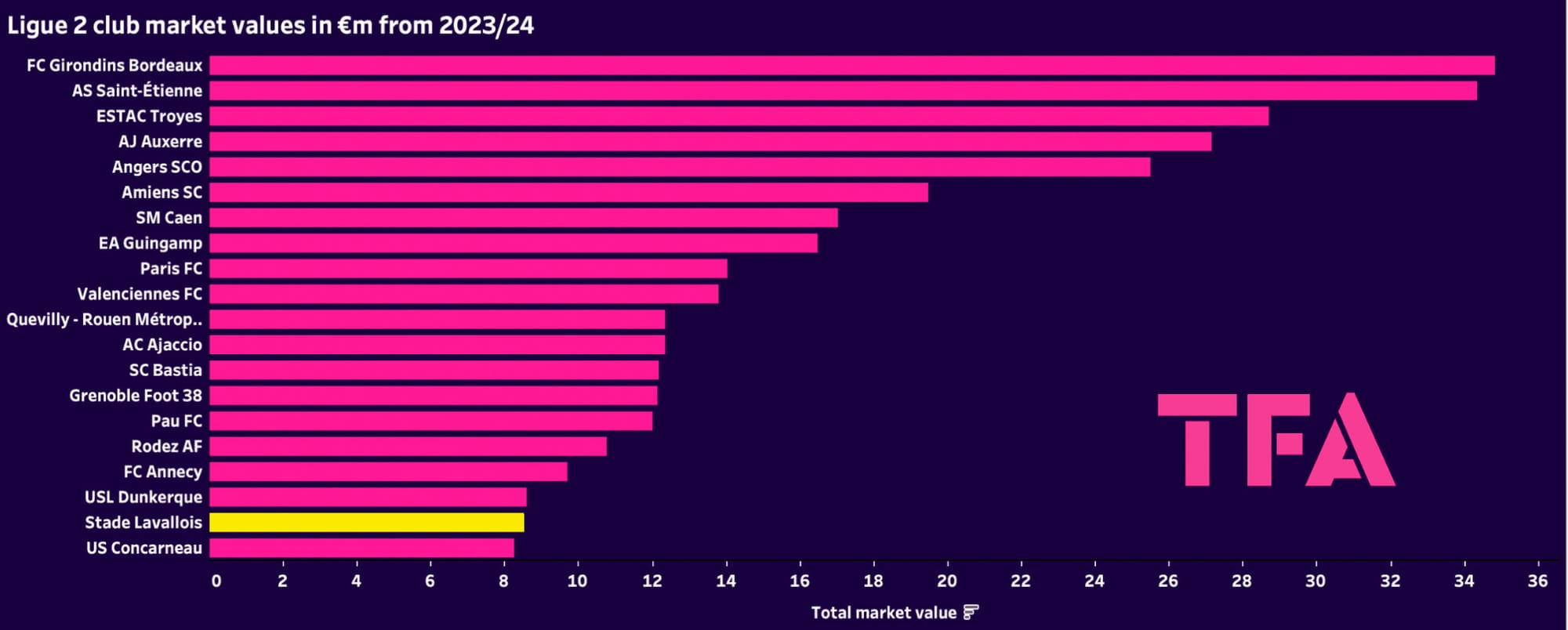
This season, Lavallois yet again rank low in terms of market value compared to their Ligue 2 rivals. They’ve moved from lowest to second-lowest for 2023/24.
However, you wouldn’t guess as much looking at their performances, which have them sitting in third place on the table at the time of writing, with three wins, one draw and one loss from their opening five games.
This term, they’ve generated the third-highest xG (8.76) and lowest xGA (3.25). However, they’ve not done a great job of converting their chances (scoring just five) and conceding four, indicating an underperformance compared to the expected numbers.
This suggests their performances have actually warranted better than they’ve delivered — and I wouldn’t expect to see any Lavallois fans massively unsatisfied with their points tally at this stage of the campaign at all.
If they can keep their performance levels as they are, they should be able to compete at the top end of the table, steering well clear of the drop zone where one might have placed them prior to a ball being kicked this term.
Lavallois’ identity on the pitch
As mentioned earlier, Frapolli has instilled a tactical identity in his side, which is clear to see when out on the pitch.
Firstly, Les Tango typically play with three centre-backs under Frapolli. Their go-to ‘shape’ over the last year has been the 5-3-2/3-5-2, though they’re also familiar with the 5-4-1/3-4-3.
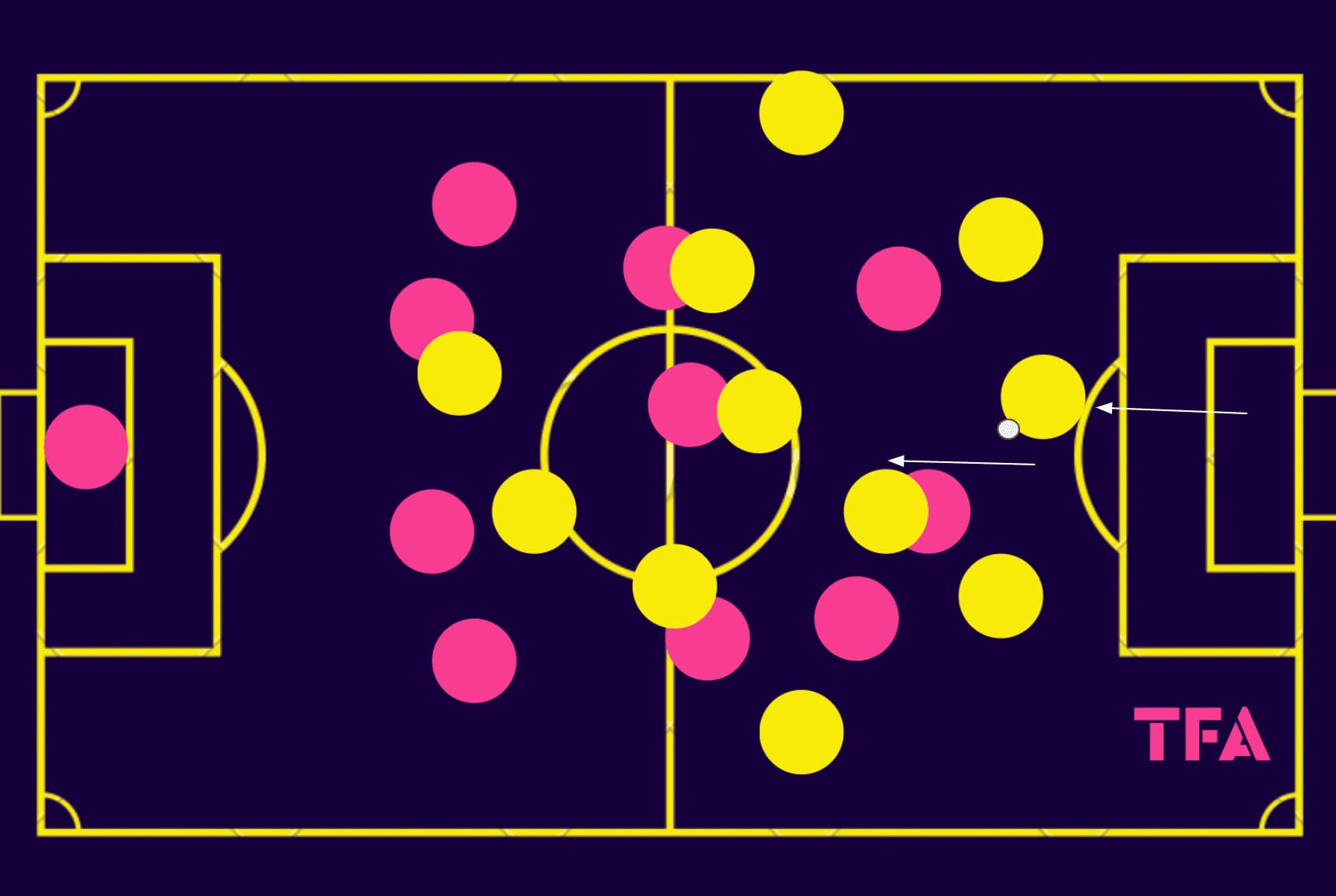
If the goalkeeper steps out with the ball, this gives the central centre-back license to push forward a bit. This movement can create a central overload for Lavallois, who end up with at least four bodies versus the opposition’s central midfielders — five if one of their two strikers also drops into midfield, which is not uncommon.
If an opposition forward follows the central centre-back into midfield to try and prevent the overload, that could open up another centre-back to simply receive and begin moving the ball forward himself.
However, in the case of figure 4, as the opposition ended up getting dragged into the centre, this freed up the wing-backs, specifically the ball-far left wing-back, to receive a long pass out wide from the ‘keeper and progress into the opposition’s half from there — an excellent example of how Lavallois’ off-the-ball movement can manipulate the opposition’s defensive structure and create passing options to facilitate ball progression.
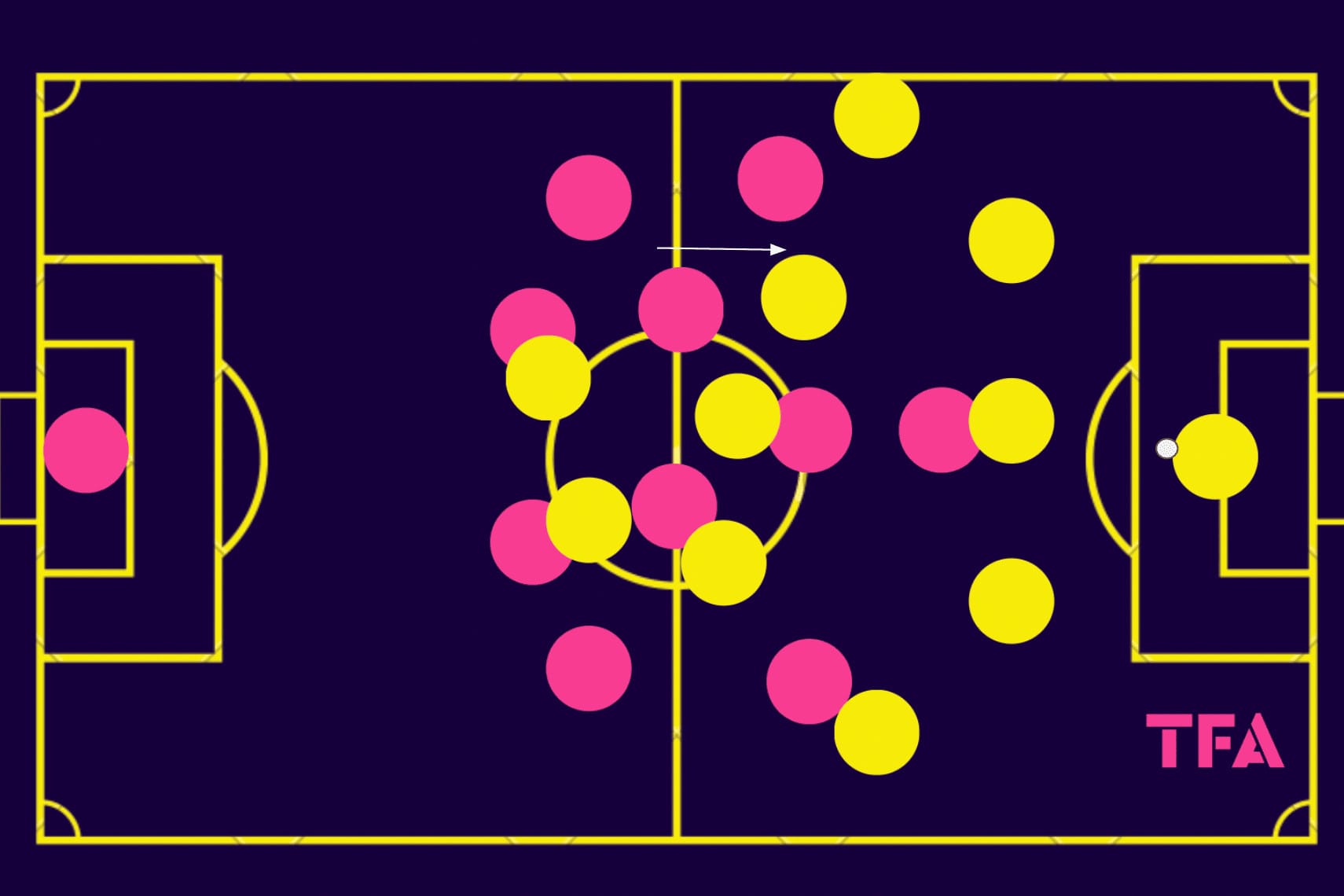
It’s not very common to see Lavallois’ goalkeeper step out like this, and a more common way of seeing them manipulate the opposition’s defensive structure via their off-the-ball movement is with the central midfielders pulling players about and moving to exploit space as they see it open up.
In this case, with the opposition defending in a 4-2-3-1, Frapolli’s right central midfielder drops into some space between the striker (attached to Lavallois’ central centre-back), ’10’ (attached to Lavallois’ central midfielder) and left-winger (attached to Lavallois’ right wing-back).
As the right central midfielder dropped, he pulled the opposition’s left-holding midfielder slightly, but not enough to prevent him from becoming a good passing option that the team could progress through, nonetheless.
If the opposition player followed the midfielder more intensely, perhaps this would’ve opened up space for a different Lavallois player to exploit in the opposition’s midfield further up, such as a dropping striker or the middle central midfielder with a forward run. Again, this highlights how the off-the-ball movement of Frapolli’s side is crucial in the build-up and ball progression phases.
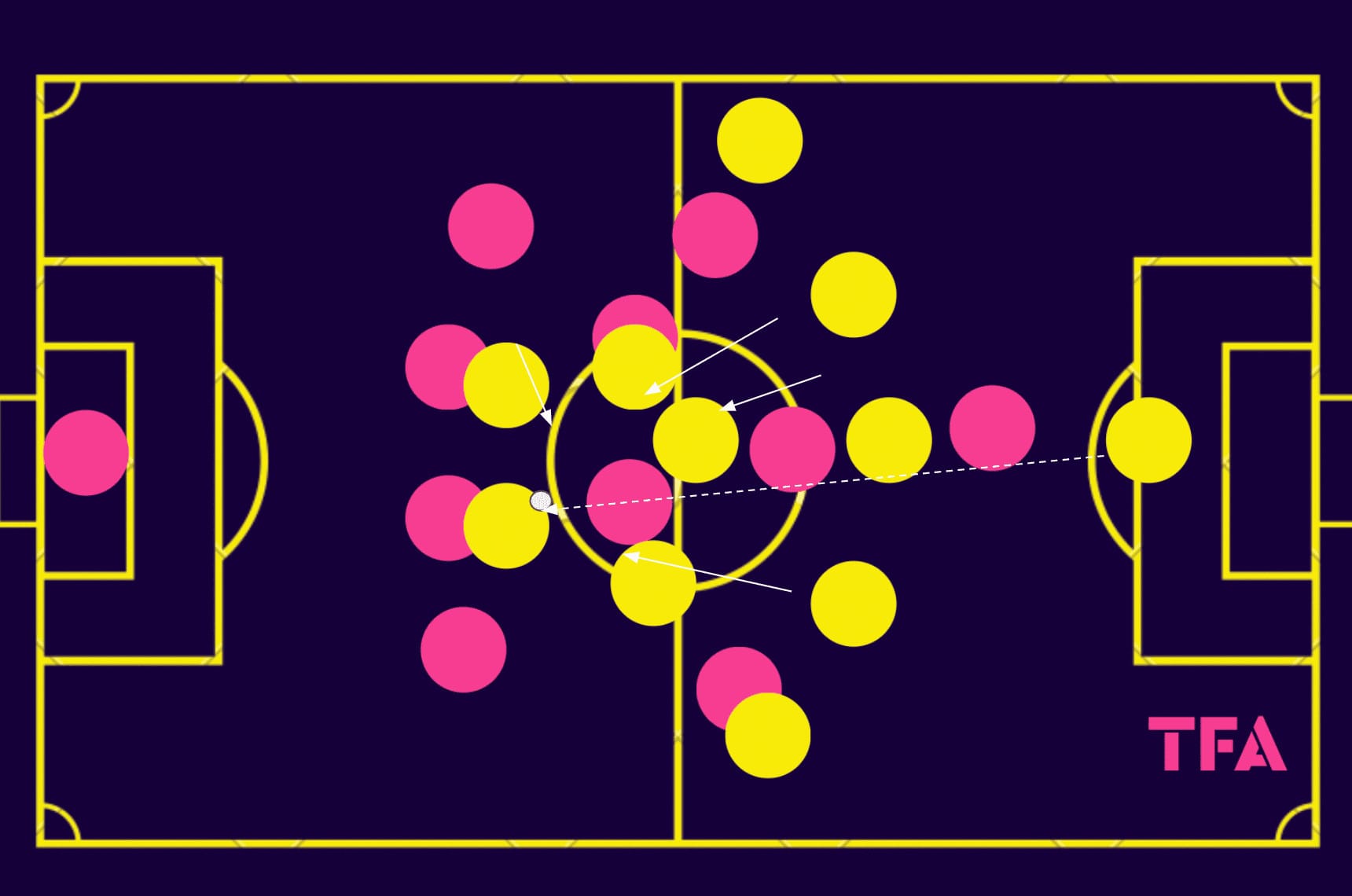
Lavallois are not a heavily possession-based side. They kept the third-lowest average possession percentage in Ligue 2 last season (46.9%), and they’ve held the fourth-lowest average possession percentage in the league at this stage of the 2023/24 campaign (44.7%).
Connected with this fact, it’s common to see them play the ball long from the back, foregoing all the intricate build-up play and intelligent off-the-ball movement we analysed that opened up exciting progressive passing lanes and instead opting to find a striker in the air and try to win the second ball in order to hit the opposition’s defence fast and hard.
In figure 6, we see an example of the centre-forward being hit by the opposition ‘keeper, creating an opportunity for that attacker to knock the ball down and set up an attack for their side.
The midfielders and the other striker gather around the drop zone to try and be in an excellent position to win the second ball or aggressively counterpress the opposition player if they get there first.
This is a typical example of Lavallois’ approach when they opt for a long ball taken from their 0-0 draw away to QRM a few weeks back. Opponents must be prepared to deal with this, which is made difficult by the quality of Les Tango’s target man and their midfield’s pressing intensity in such situations.
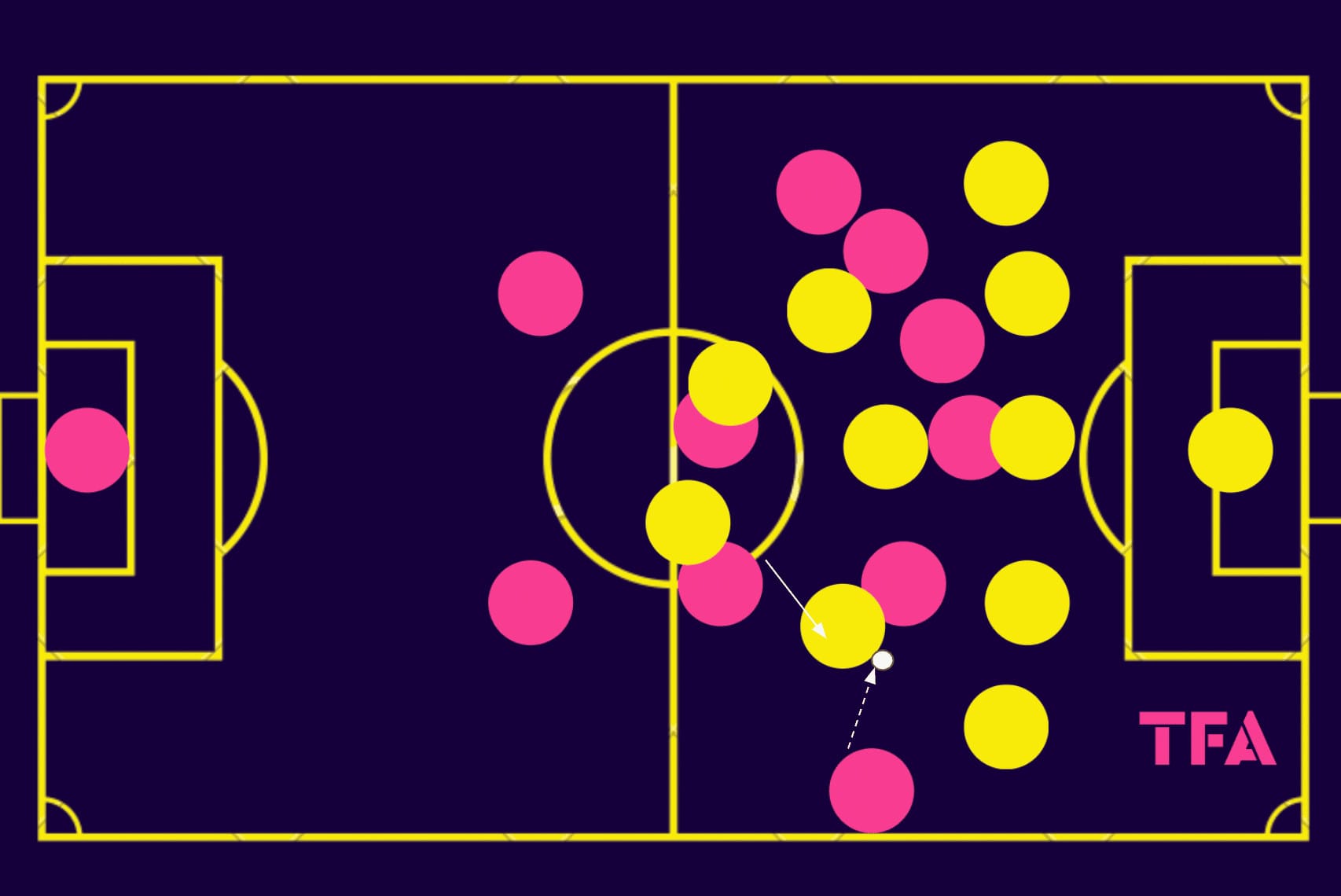
Out of possession, Lavallois typically don’t defend very aggressively — they had the eighth-highest PPDA in the league last season (11.47) and have the sixth-highest PPDA in France’s second-tier (13.71) this term.
It’s far more common to see them defending in a mid-low block as opposed to a high block, which they usually forego, allowing the opposition to progress to about the halfway line before engaging in defensive actions.
Their wing-backs often defend aggressively at this point, pushing up the wing on either side of the midfield. Due to the compact nature of the centre of the pitch, the ball is often forced out wide, meaning Lavallois’ wing-backs have to engage in a high number of defensive duels, as do the wide centre-backs who then need to cover the wide space behind the wing-backs.
Frapolli’s wide central midfielders also engage in a high number of defensive duels. Their positioning and spatial awareness need to be on point throughout a game to read play and put themselves in the best possible place to make an interception, as was the case in figure 7 above.
A big part of Frapolli’s attacking approach lies in the transition to attack. His side are good at quickly threatening the opposition by regaining possession in a position like we see here above and surging forward, finding space, free players and, ultimately, goalscoring opportunities as they burst forward into the final third.
However, this always begins with Lavallois’ defensive organisation and capability, and their ability to do this consistently is a testament to Frapolli’s ability to train such a well-orchestrated defensive structure.
Malik Tchokounté, 35 years old, centre-forward
For our final sections of this analysis, we’ll highlight some key players to watch this season who could take this team to the next level. We’ll analyse what they offer Frapolli’s side and how they fit into the coach’s overall strategy in Laval.
The first of our three key players is centre-forward Malik Tchokounté, who joined Frapolli’s side on a free transfer from Nîmes Olympique this past summer following the latter’s relegation from the second-tier.
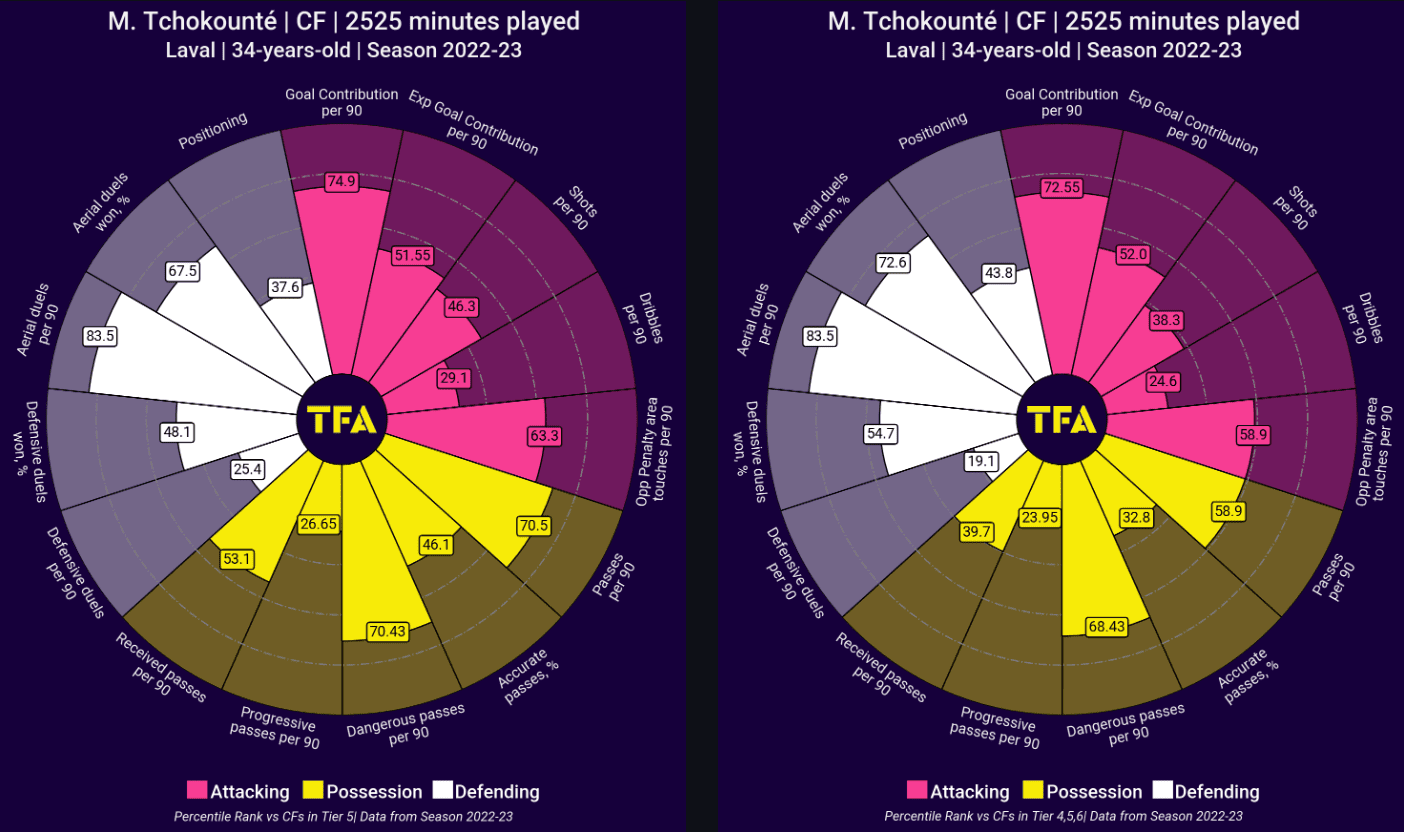
We’ve opted to use all players’ data from the 2022/23 season rather than 2023/24 due to the small sample size and early stage we find ourselves in this term. Therefore, all data related to Tchokounté’s performances come from his time at Nîmes in Ligue 2 last season.
Our left-sided chart shows his percentile ranks in specific notable areas related to other strikers from ‘Tier 5’ leagues, of which Ligue 2 is one, and the right-sided chart compares his percentile ranks with those of strikers in Tiers 4, 5 and 6 for last season.
Regarding passing, Tchokounté ranks well in dangerous passes in both charts and above average in received passes among Tier 5 strikers.
Unsurprisingly, the forward’s aerial duel stats stand out as being among his best. At 191cm/6’3″, 90kg/198lbs, Tchokounté represents a significant physical presence for Lavallois in attack, who the ‘keeper/centre-backs can aim for from long balls — hence why Les Tango can be so difficult to deal with from this attacking approach — and crossers can aim for from out wide.
Tchokounté’s physical presence undoubtedly makes him a unique threat that many centre-backs, though also physical, struggle to cope with.
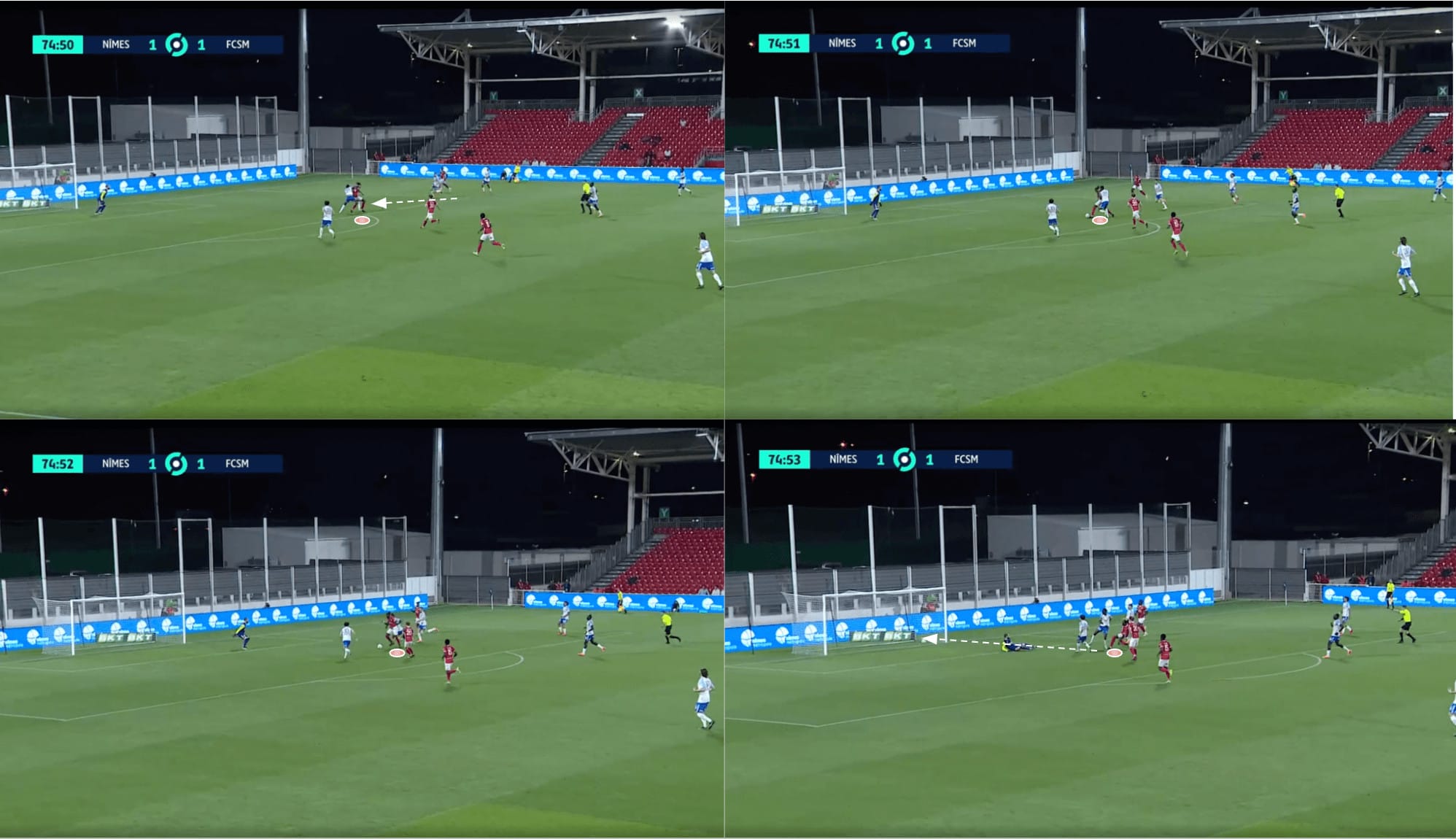
Take this example from his time at Nîmes last season, for instance. Here, we see Tchokounté receiving with his back to goal but quickly turning the situation into one where he’s bearing down on goal in an excellent position to convert on his weaker left foot — not that much of a weakness for him.
Initially, as the pass is played to him, he receives well after setting himself in a wide-bodied stance, making it near-impossible for the centre-back behind to shove him off-balance.
He can hold off that defender without issues while turning and entering a precious goalscoring position from where he can slot the ball home.
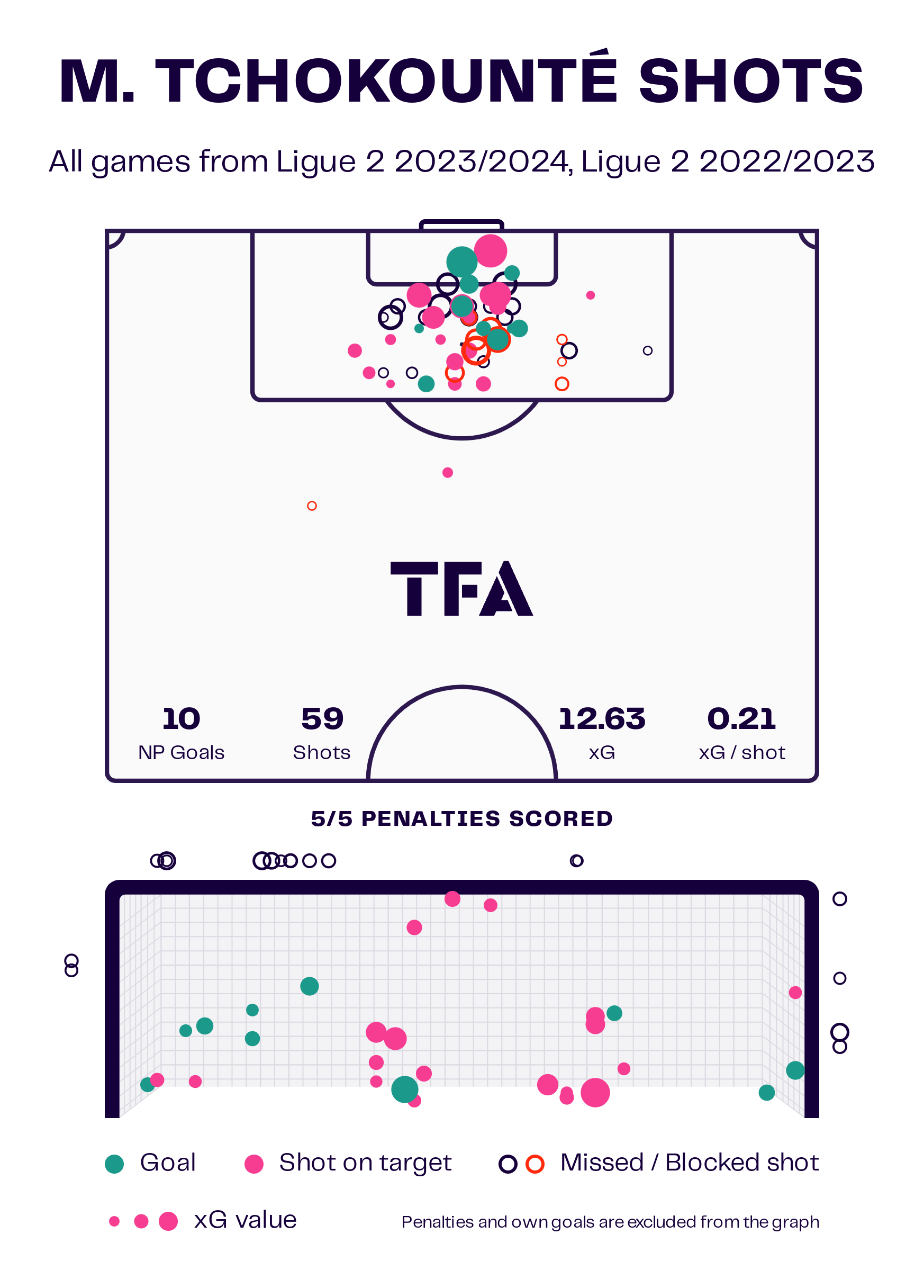
Lastly, Tchokounté’s goal contributions and expected goal contributions rank highly among Ligue 2 centre-forwards. This is largely thanks to the forward’s excellent positioning and shot selection. The 35-year-old’s shot map from this season and last show all locations of his 10 non-penalty goals as well as his stellar 0.21 xG per shot rate.
The 6’3 striker is excellent at occupying high-percentage areas and getting shots off from there. This is partly thanks to his teammates’ great work in chance creation to work the ball to him, as well as the massive target he represents in such high-value areas.
Tchokounté’s off-the-ball movement combines with his imposing size to create a great offensive weapon for Frapolli this term, which could end up helping them to compete higher up the table than last term, representing progress and success for Les Tango.
Thibaut Vargas, 23 years old, right wing-back
Second on our list is Thibaut Vargas — a 23-year-old who typically plays at right wing-back for Lavallois, having also played for Nîmes Olympique last season before making the move to Laval this summer.
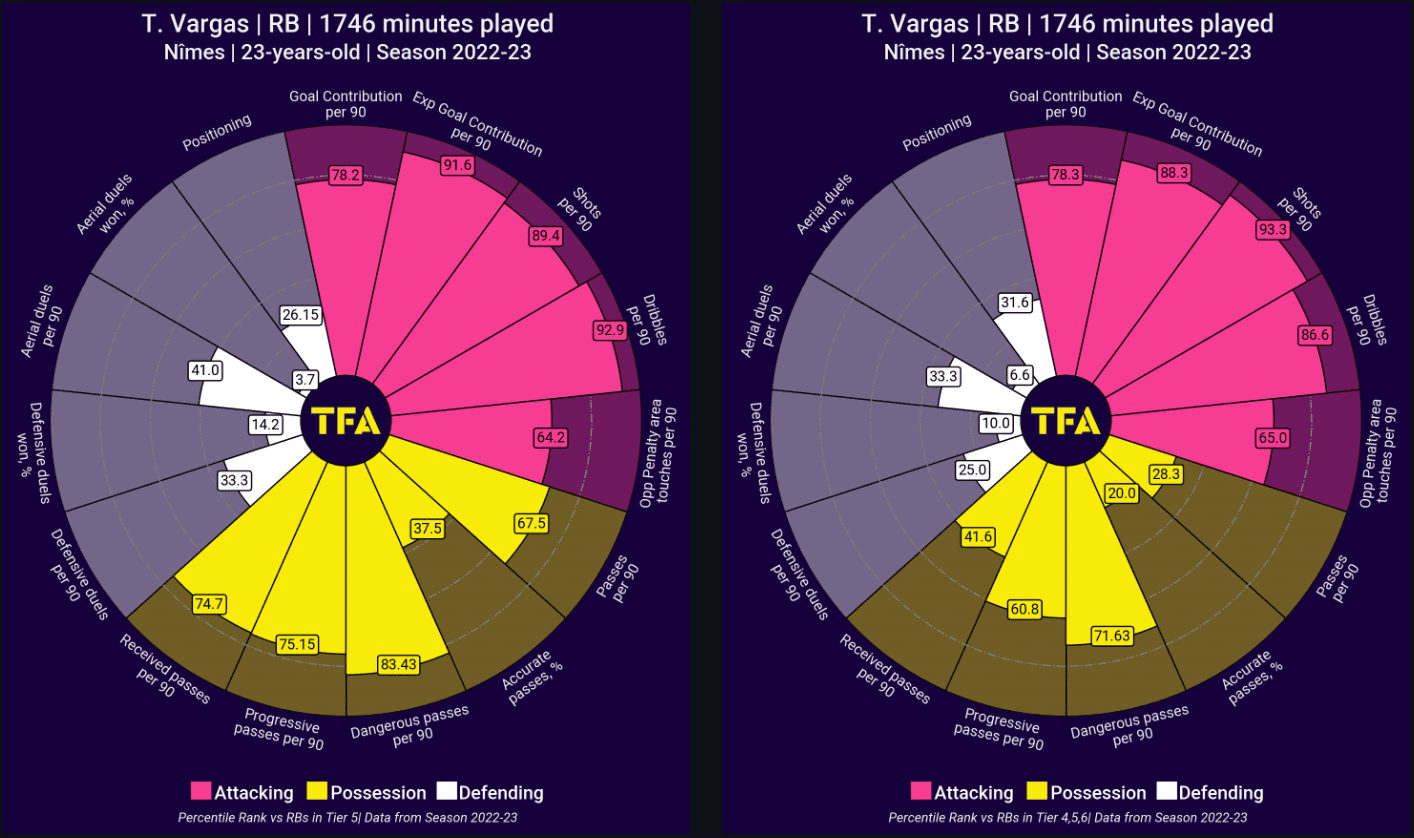
We view the 175cm/5’9, 68kg/149lbs wing-back as a potential key player for his new club this season, largely thanks to his ability to create chances from the right wing. Both Nîmes and now Lavallois have relied on his crossing ability to generate chances mostly for Tchokounté and the major threat the big forward presents in the box.
The 23-year-old has stellar expected goal contributions per 90, dribbles per 90 and dangerous passes per 90 rankings, all of which result from his incredible chance-creation ability on that right wing as well as his set-piece taker threat — it’s always nice to have one of those in the squad.
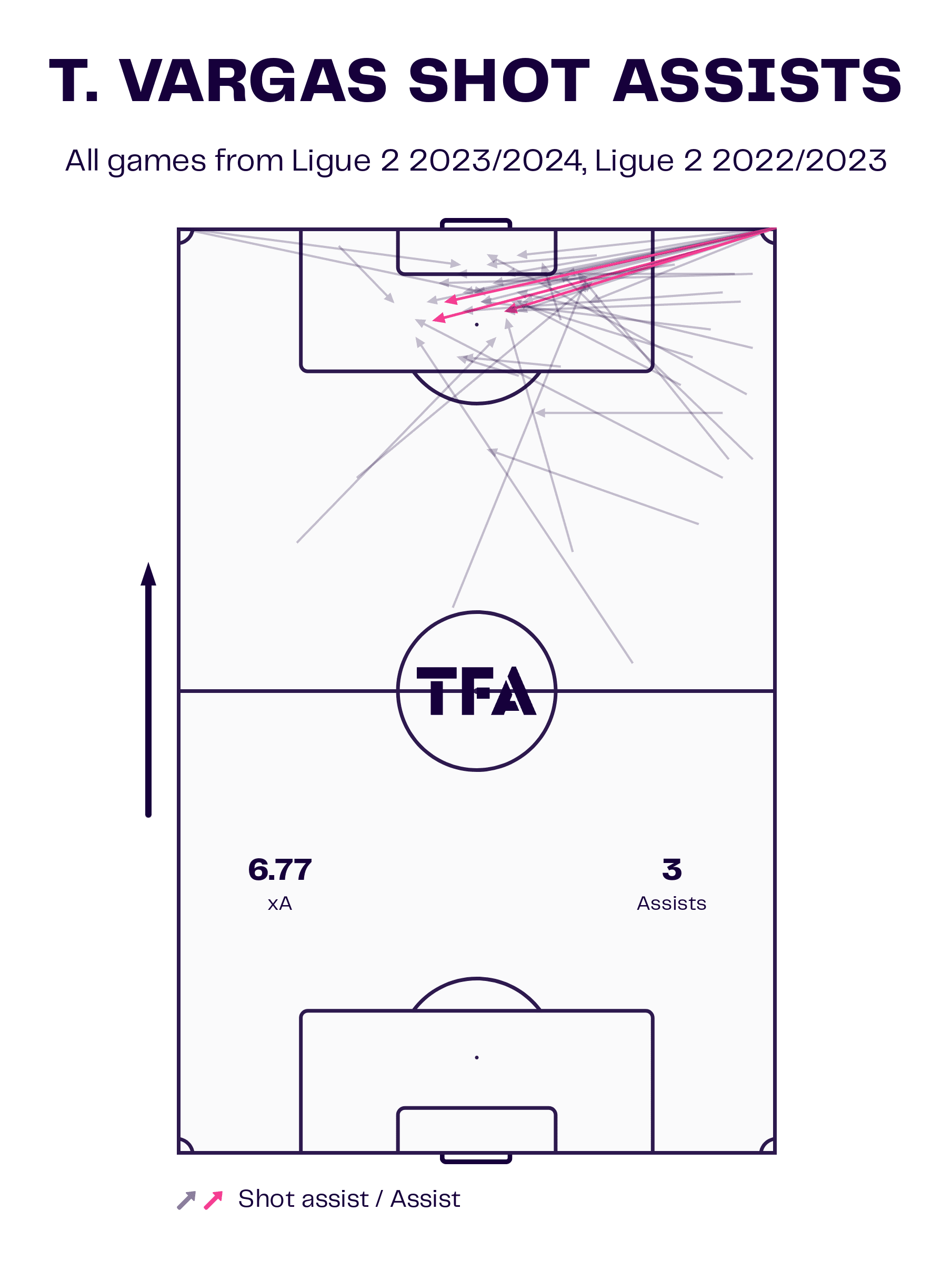
While Vargas has made just three actual assists between this season and last, he’s generated 6.77 expected assists in that time, suggesting that he should have about double the amount of assists based on the quality of chances he’s created.
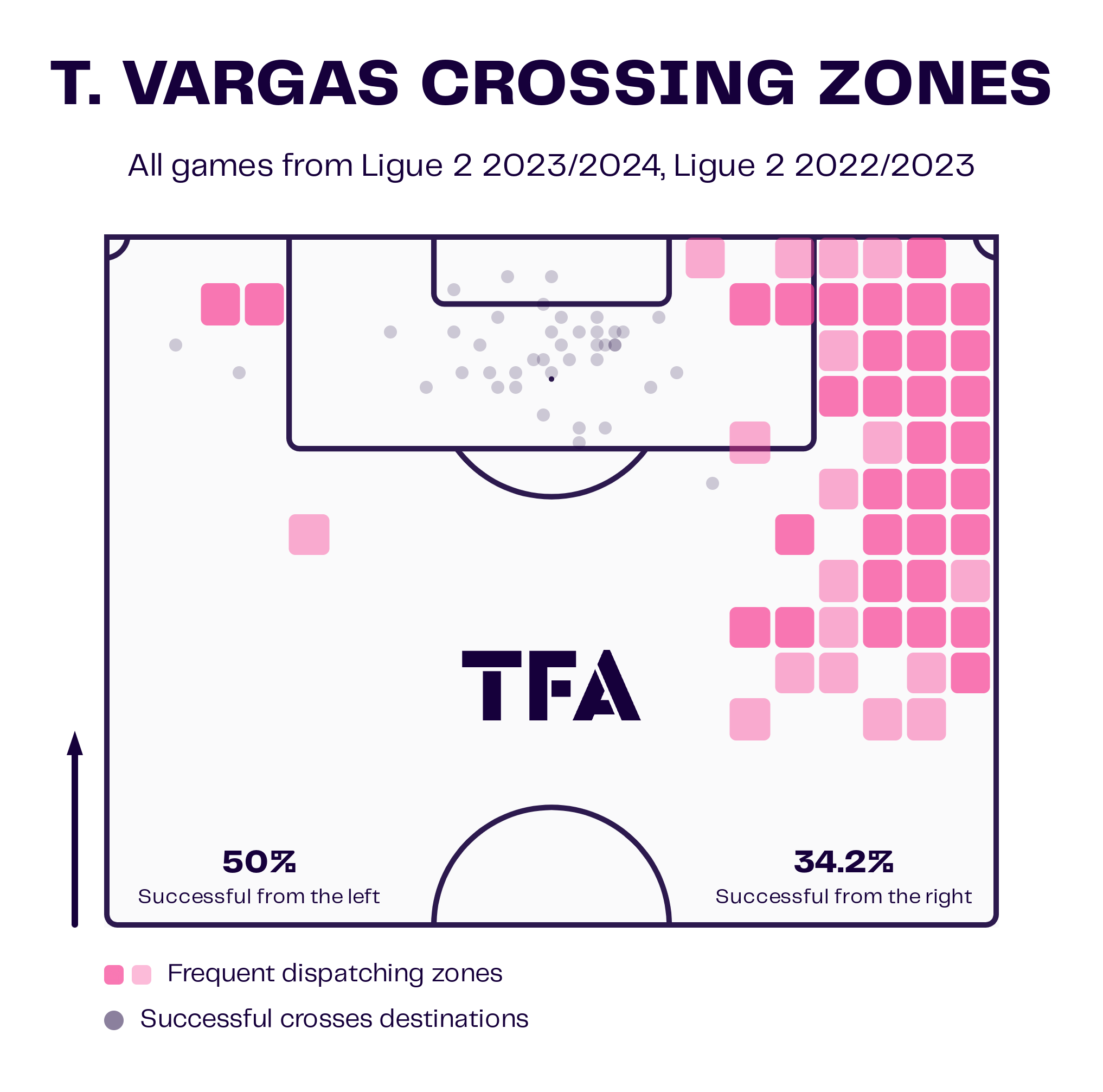
Figure 13 highlights the 23-year-old’s primary crossing zones over this season and last. Here, we can see he doesn’t just cross from advanced positions but sends plenty of balls into the box from deep as well.
Combined with intelligent movement in the box from Tchokounté, Vargas’ early crossing can be another significant offensive weapon for Frapolli and Lavallois.
You can expect to see Les Tango rely on Vargas’ creativity quite a bit this season and aim to get a lot out of the connection between the 23-year-old wide man and their 35-year-old star striker.
Elhadji Pape Djibril Diaw, 28 years old, left centre-back
Last but not least, we’ve chosen to highlight Lavallois’ 28-year-old left-sided centre-back, Elhadji Pape Djibril Diaw, and his important role with the Ligue 2 outfit where he arrived on loan from Ukrainian Premier League side Rukh Lviv in the summer of 2022.
This makes him the only one of our three players to watch who was at Stade Francis Le Basser last season. However, we still see him as someone who can elevate his team to greater things this term because he was injured for most of last term.
This also means we have a relatively small sample size for his 2022/23 data, but this data, combined with our own video analysis, led us to some key conclusions that we’ll discuss here.
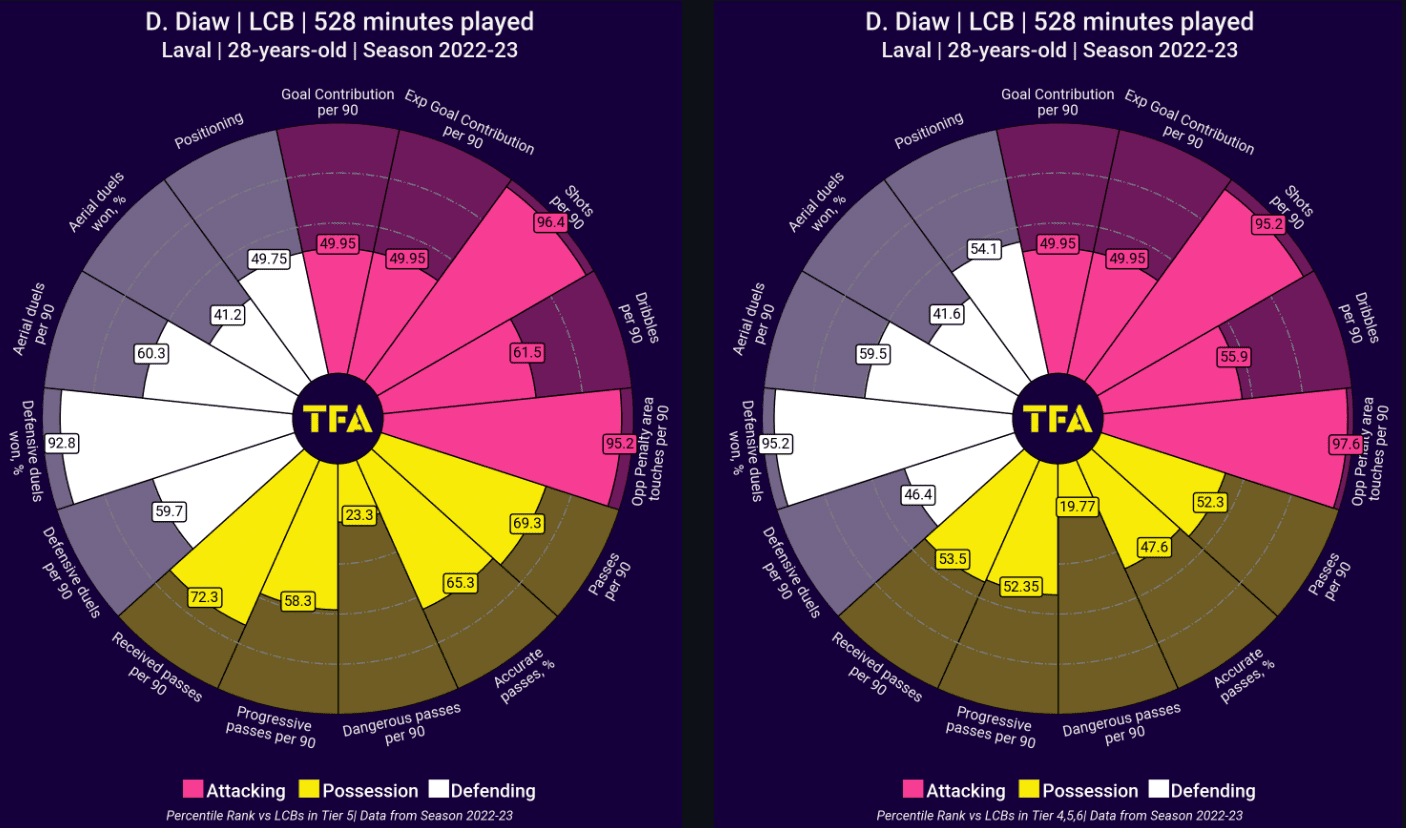
Diaw has proven a very reliable defender at this level based on the minutes we’ve observed so far. His percentile rank for ‘Defensive duels won %’ is highly impressive, along with a decent volume of defensive duels to boot, with the 28-year-old performing that wide centre-back role that requires him to cover behind the aggressive left wing-back and engage opponents in high and wide positions at times.
He has now played 764 Ligue 2 minutes over the last calendar year, and he’s got a 78.95% defensive duel success rate in that time, which is exceptional. His availability to start the 2023/24 campaign has played a large part in his side conceding the lowest xGA of any Ligue 2 competitors, with Diaw playing every minute for Frapolli’s team thus far.
At 191cm/6’3″, 91kg/200lbs, Diaw provides yet another major threat from set-pieces to join Tchokounté in the opposition’s box and provide Vargas with an option. His aerial ability is not of the same quality as Tchokounté, but, again, he’s a major threat that the opposition must be concerned with.
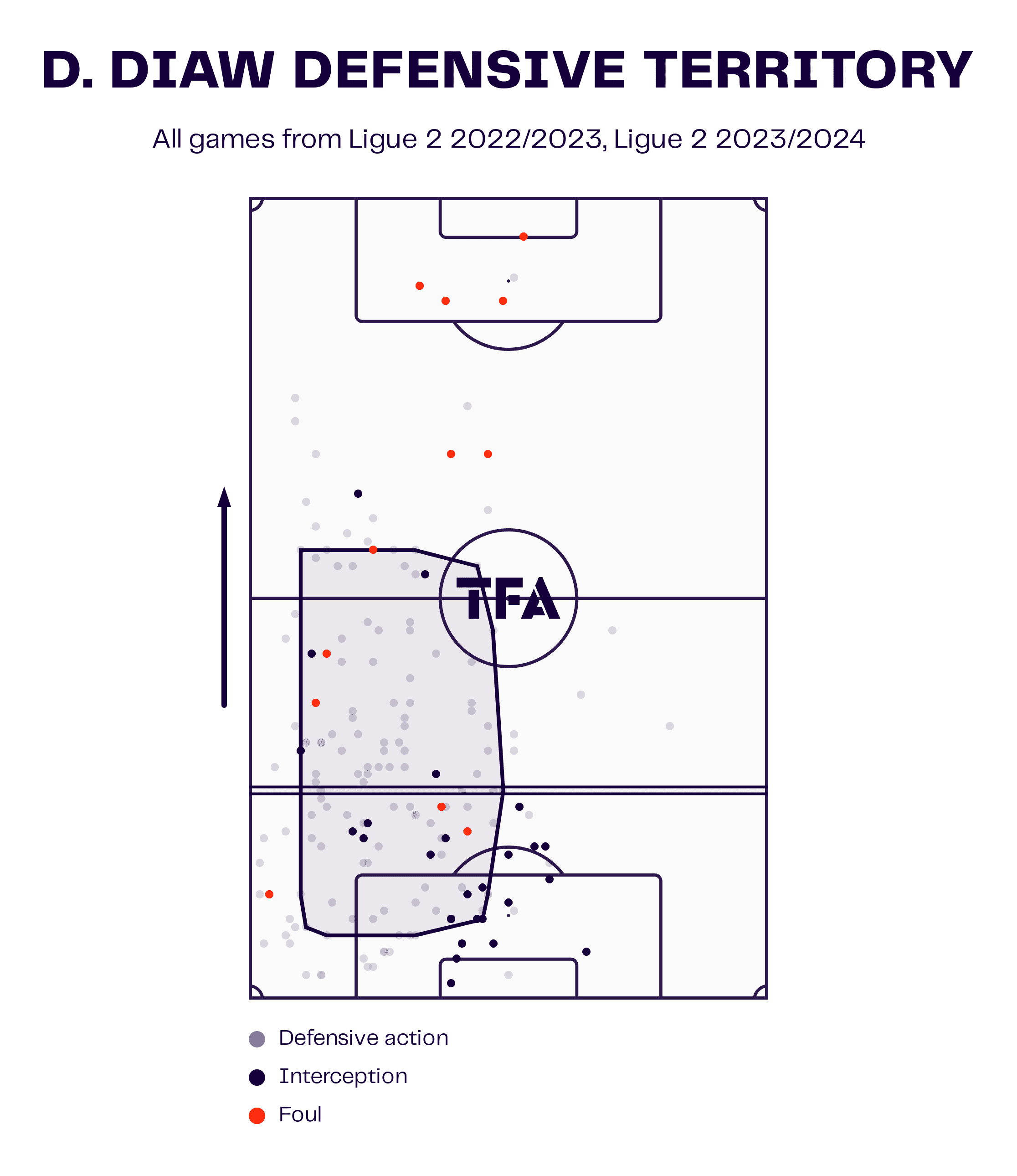
Again, though, his defending really earns him his place on our list, with Diaw’s combination of physicality, technical defensive ability and timing proving very difficult for opposition attackers to combat.
Frapolli’s team will be a more formidable outfit throughout the campaign if they can keep Diaw fit.
Conclusion
To conclude this tactical analysis piece, it’s clear to us that Frapolli is one of the premium coaches on the rise in France outside of Ligue 1 at the moment and deserves plenty of recognition for his achievements with Lavallois.
How far can he take the team with the second-lowest squad market value in the league this season? Only time will tell, really, but based on their stellar start, we see no reason they can’t vastly outperform their market value and compete at the higher end of the table. However, despite their promising beginnings, we wouldn’t be quite confident enough to say they’ll challenge for promotion.
A season spent mainly competing in the mid-table would be a great result and an excellent sign for the future, which is perhaps a more realistic prediction here.





Comments